| Article ID | Journal | Published Year | Pages | File Type |
|---|---|---|---|---|
| 9109512 | Placenta | 2005 | 8 Pages |
Abstract
Bisphenol A (BPA) is a monomer of polycarbonate plastics that has estrogenic activities and has been shown to be a substrate for multidrug resistant efflux mechanisms, specifically, P-glycoprotein. Since the natural hormone estrogen reverses multidrug resistance in some cell types, we hypothesized that BPA might have a similar activity in trophoblasts. We have used BeWo cells as an in vitro model for human trophoblasts and calcein AM as a substrate for drug efflux mechanism to characterize BPA interactions with placental P-glycoprotein. We found that chronic exposure of BeWo cells to BPA did not alter intracellular calcein accumulation in a fashion that would be reflective of changes in P-glycoprotein expression. Immunoblots affirmed that BPA had small effects on P-glycoprotein expression. However, BeWo cells acutely exposed to BPA pretreatment were observed to have a significantly decreased calcein accumulation. Addition of cyclosporin A, a P-glycoprotein inhibitor and substrate, completely reversed BPA's effects on calcein accumulation and resulted in a net increase, relative to controls, in calcein accumulation by the BeWo cells. BPA was found not to stimulate P-gp ATPase or alter intracellular esterases mediating calcein release from calcein AM. Therefore, our results suggested that BPA stimulated drug efflux by BeWo cells probably by direct effects on P-glycoprotein.
Related Topics
Life Sciences
Biochemistry, Genetics and Molecular Biology
Developmental Biology
Authors
H. Jin, K.L. Audus,
